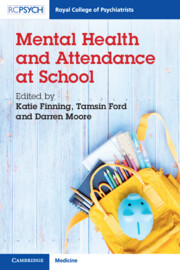Book contents
- Mental Health and Attendance at School
- Mental Health and Attendance at School
- Copyright page
- Contents
- Contributors
- Preface
- Acknowledgements
- Chapter 1 Mental Health and Attendance at School
- Chapter 2 School Attendance
- Chapter 3 Emotional Disorders and Attendance at School
- Chapter 4 Behavioural Disorders and Coping with School
- Chapter 5 Neurodevelopmental Disorders and Attendance at School
- Chapter 6 Educating a ‘New Me’ after an Acquired Brain Injury
- Chapter 7 School Influences on Attendance and Special Educational Needs
- Chapter 8 Supporting the Attendance of Vulnerable Children at School
- Chapter 9 School Attendance and Anxiety
- Chapter 10 Reflections on the Impact of Covid-19 on Children’s Education and Mental Health
- Index
- References
Chapter 4 - Behavioural Disorders and Coping with School
Published online by Cambridge University Press: 24 March 2022
- Mental Health and Attendance at School
- Mental Health and Attendance at School
- Copyright page
- Contents
- Contributors
- Preface
- Acknowledgements
- Chapter 1 Mental Health and Attendance at School
- Chapter 2 School Attendance
- Chapter 3 Emotional Disorders and Attendance at School
- Chapter 4 Behavioural Disorders and Coping with School
- Chapter 5 Neurodevelopmental Disorders and Attendance at School
- Chapter 6 Educating a ‘New Me’ after an Acquired Brain Injury
- Chapter 7 School Influences on Attendance and Special Educational Needs
- Chapter 8 Supporting the Attendance of Vulnerable Children at School
- Chapter 9 School Attendance and Anxiety
- Chapter 10 Reflections on the Impact of Covid-19 on Children’s Education and Mental Health
- Index
- References
Summary
This chapter explores how behavioural difficulties and attendance at school can affect each other in different ways and aims to help practitioners to think more about what it is the child is communicating through their behaviour. The chapter considers behaviour in the context of normal development and defining behavioural difficulties and disorders. It moves on to consider behavioural difficulties in relation to attendance and exclusion from school. The chapter emphasises the need to avoid taking behaviours at face value and exploring the child’s individual needs, in the context in which this behaviour is arising, through thinking about adverse childhood experiences, attachment and wider influences. In thinking about the possible needs of the child through holistic assessment the chapter ends with some considerations around moving forward and what we can do to support a more positive trajectory. We hope that practitioners will see the importance of remaining open and curious about behaviour to further understand and support the children and young people they work alongside.
- Type
- Chapter
- Information
- Mental Health and Attendance at School , pp. 59 - 77Publisher: Cambridge University PressPrint publication year: 2022



